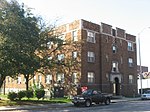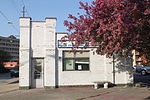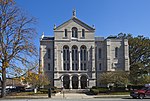Riley Towers

Riley Towers are three residential high-rise apartment buildings in downtown Indianapolis, Indiana, United States. Riley Towers were conceived as part of an expansive urban renewal project known as Project H. The complex was constructed between 1962 and 1963. Towers I and II have 30 floors and Tower III has 16 floors. Riley Towers I and II are the tallest residential buildings in the state of Indiana. The towers are distinctive for their cantilevered corner balconies.The complex is owned and managed by Indianapolis-based Barrett & Stokely, Inc., which purchased the property in 1993. Amenities include a three-level parking garage; a private outdoor swimming pool, lounge, and grilling area; a fitness center; and ground-level retail. An open-air skyway spans E. North St., connecting Tower I to the complex's parking structure. The complex is named for famed poet James Whitcomb Riley, whose museum home stands in the nearby Lockerbie Square Historic District.
Excerpt from the Wikipedia article Riley Towers (License: CC BY-SA 3.0, Authors, Images).Riley Towers
East North Street, Indianapolis
Geographical coordinates (GPS) Address External links Nearby Places Show on map
Geographical coordinates (GPS)
| Latitude | Longitude |
|---|---|
| N 39.775138888889 ° | E -86.152833333333 ° |
Address
Riley Towers I
East North Street 225
46204 Indianapolis
Indiana, United States
Open on Google Maps









